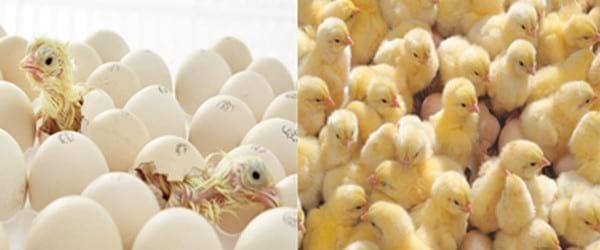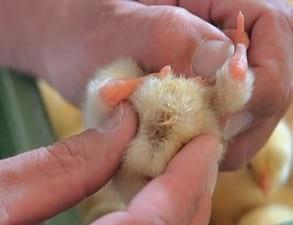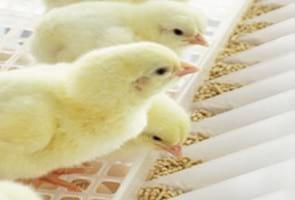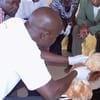Poultry Industry forum -Those First 7 Days
Published: April 20, 2016
By: Dr. Odede Rezin

Chicks are still in the Hatcher
Mother hen does not exist in modern poultry business. Mother hen under her ‘brood’ keeps her babies away from extreme weather conditions and from predators. She is conveniently replaced by equipment for source of warmth, shelter, ventilation, light all provided artificially by men or women of wisdom! The baby chicks are confined to a specific area. They are not allowed to see the sun, the moon and the stars!
We do not have to teach a mother to look after her baby. She knows it. The maternal instinct innate in her tells her what to do and why.
Even though the simple outmoded mother hen does not exist in these modern times, she exists in spirit in YOU. She should! You become the foster parents to the baby chicks. Over so many decades, mass industrial production norms have replaced Tender Loving Care (TLC) and chicks are often subjected to a myriad of stressors especially during the first 24 hours and in general in the first 7 days and beyond, of their life with you.
Increased early chick mortality or a hike in the number of weaklings is an aftermath of the vagaries of such stressors. Whatever the form of stress that the baby chicks undergo in the early stage of their life will have a telling effect on their overall performance, having reduced body weight, increased feed conversion and high mortality that invariably results in increased cost of production.
Quality chicks
The birds have to develop fully from both physiological and anatomical perspectives.
A good 7 day weight is an excellent indicator of performance to unfold later. In fact the rule of thumb is attaining a 7th day weight approximately four or four and half times higher than the Day 0ld weight. That means, a 40 Gm day old chick should weigh about 160 to180 Gms at 7th day. This weight also reflects a maximum gut (GIT) development in the first week, and eventually higher final weight and excellent FCR (Feed Conversion Ratio).
The chicks would have achieved good uniformity with sound skeletal structure. It is a dynamic process, starting way back even in the life of the breeder, its nutrition and health, egg handling and hatching process, nutrition and management of chick itself. The chicks would have achieved good uniformity with sound skeletal structure. It is a dynamic process, starting way back even in the life of the breeder, its nutrition and health, egg handling and hatching process, nutrition and management of chick itself. |  | |
| Omphalitis is preventable |
Omphalitis: Also known as yolk sac infection, mushy chick disease, and/ or navel ill. Even though a number of bacterial species are involved major ones causing this condition are E.coli. Mortality can be 5-10% and posses a great challenge to the performance of survived chicks. Post mortem of affected dead chicks usually reveals discolouration around the navel and an inflamed yolk sac with an offensive smell. Good hygienic practices in the breeding farms, hatchery and in the brooder house are essential in order to prevent this problem. We should reject any contaminated eggs for hatching and caution should be taken in handling hatching eggs from laying nest to setter. If the navel is open bacteria will have an easy access to the yolk. Hatcheries should make sure that optimum temperature, humidity and hygiene are maintained while chicks are being hatched.
Early feeding and the optimum temperature in the brooder house will also help yolk sac to be absorbed faster.
Can you believe this! Life begins for a chick 9 days before an egg is laid, as this is the time that it takes for the follicle (which becomes yolk) to mature. Nutrient content of yolk may be sensitive to availability of some very essential nutrients as amino acids, phosphate, essential fatty acids and certain vitamins. Reminder of the egg, albumen, various membranes and the shell are deposited during the day prior to lay. Excess or deficiency of certain minerals can lead to embryo mortality. Zinc and Selenium improve maternal antibody transfer and chick quality. Dietary inclusion of vitamins has a greater impact on fertility and embryo viability, so hatchability. Fat soluble vitamins (beta carotene and vitamin E) can increase lymphocytes proliferation and the ability to improve the immune system.
The research has showed that in vivo injection of nutrients by 18th day of incubation has improved nutrient reserves of embryos and chicks and stimulates rapid maturation of the gastrointestinal tract post hatch.
Feeding chicks
The post-hatch nutrition of the broilers is a crucial aspect of broiler rearing.
 |  | |
| Chicks eating at the Hatcher! | Correct brooding is paramount |
(HatchCare system)
The combination of energy supplied by the yolk (endogenous) and utilization of carbohydrate-rich feed (exogenous) through the intestine bring about dramatic changes to their size, morphology and function of the intestine.
Considering the fact that the chicks have to be fed and given drinking water as early as possible after they hatch out, a number of hatchery manufacturers have developed a system to provide and water for them at the Hatcher itself! (Please see the picture above)
It has been observed that delaying placement by 15 hours 7-day weight was reduced by 20 Gm and 40 day weight by 80 Gm. A recent finding is that delaying feeding for 2 days could result in a reduced body weight at the end by approximately 8-9% and that gastrointestinal tract, immune and thermoregulatory system could not be developed optimally.
The effect is greater in the chicks coming from young breeding flocks. In fact the young hen is likely not to transfer all the appropriate nutrients into the hatching eggs. Therefore, quality of a one day old chick, broiler or pullet, starts from the health and nutrition of breeder birds, breeder egg management and through hatching and the post hatch management until they get a comfortable and warm welcome at the brooder/grower house.
The embryo inside the egg grows with the various egg nutrients contributing to its development, its immune system, and general heath of the chick. About 90 per cent of energy needs and all other nutrient requirements for the chick embryo are drawn from yolk lipids and are directly transported through blood circulation. Therefore, nutrients in the egg are a direct reflection of the quality of the chick!
The fact is that the genetic potential of a chick is expressed fully if the chick’s gastro-intestinal system is excellent.
In fact, Gastro Intestinal Tract (GIT) grows four times faster than the body weight of a broiler during the first two weeks of life. The intestinal villi (essential for the absorption of nutrients) in the upper part of small intestine (duodenum) develop maximum at 4 days and villi at the lower part of small intestine (jejunum and ileum) develop maximum at 10 days of age. Therefore, to realize the maximum development of GIT good quality feed and water should be made available to chicks as soon as possible after hatching. If we delay further, the development and therefore performance invariably suffers.
It is proven and reported abundantly that longer delay in providing feed and water to the chicks after the hatch results in reduced body weight.
As mentioned earlier, the weight at 7 days age is paramount and not negotiable. If the birds are ready for processing at 35 days, the 7 days form about and above 20% of their total age. A good start leads to good uniformity and excellent final body weight, achieving a great feed conversion. Approximately 80% of yolk is absorbed by the developing embryo during incubation; the remaining 20% is drawn into the abdominal cavity before hatching. The yolk thus remains in the chick and is about 10 to 28% of one day body weight of the chick. If feed and water are not consumed by the chick at optimum and as early as possible, there will be delay in yolk sac absorption, causing some early chick mortality after 3 days of age, and creating more culls and unthrifty chicks.
Even though there are different methods used to determine performance such as live weight, growth, crop fill, body temperature, and livability, measuring 7th day weight is the best assessment of quality of chicks, pre-placement and brooding management.
Clean House
In order for the chicks to perform, perform to maximize their genetic potential, they should not get sick, stressed, weak, under-weight or dehydrated when they start their life.
One challenge the day old chicks have to face is the lack of cleanliness and so the ‘germ build up’ of their surroundings in and out of the poultry house. Even the healthy chicks easily get stressed out, infected and become weak and highly susceptible to new infections when they grow further in a poorly sanitized farm.
The surrounding should be thoroughly cleaned, dry cleaned and cleaned with water, sanitizers and disinfectants. Any organic material, dirt or remnant of litter will undermine the efficacy of any disinfection exercise.
As we know, basic life needs of chicks are warmth, fresh air, clean water and good quality feeds.
Warmth
After hatching, the chicks are still in transition (from cold blooded to warm blooded stage) and their thermoregulatory (generating and maintaining body temperature) function is yet to be fully operational. More over, the chicks tend to lose greater amount of heat due to their increased basic metabolic rate. Heat is also required for proper development of immune system which begins as early as the first couple of days. If the heat is not provided at the right levels and not on time, the chick gets retarded, shows susceptibility to diseases and ends up ultimately as poor performer.
Provision of heat at the chicks’ level is therefore so important; about 31/320C in the first week. Please do with out fail the preheating of brooding area about 6-12 hours before the placement of chicks so that the litter temperature reaches 31/320 before the chicks are placed. When the charcoal brazier (mbaula) is used for brooding, care should be taken to see that all charcoal is burnt and no more (visible) smoke which is toxic to chicks comes out of it before it is brought inside the brooder house. Please make sure that an opening is provided at the top above the side curtain through out the house for this smoke and invisible smoke (carrying carbon dioxide and carbon monoxide) to escape from the house. Please do not forget that brooding is not only the provision of heat but also protecting the chick’s respiratory system comprising of trachea, bronchi, lungs and air sacs. Remember, these obnoxious gases and other contaminants in the brooding area not only depress the growth but also damage the respiratory system resulting in respiratory complications and metabolic disease conditions such as Ascites and flip over syndrome. So, please adjust the heat source and aeration so that the chicks are active, comfortable, feeding and drinking water consistently and spread out uniformly, most of the time. The crop is empty if the chicks are not feeding and drinking. With in the first 24 hrs of brooding most of the chicks should have crop filled with feed and water. Checking ‘Crop fill’ is a management tool to get a feel of chicks’ performance in their early days.
Feed and water
Before releasing the chicks to the brooder, please dip their beak in water. Chick feeders and drinkers are placed uniformly around the heat source so that the chicks have easy access to both feed and water. Spreading news paper over the litter helps prevent chicks from litter eating and get cleaner and unsoiled water and feed in the first few days of their life. Feed can also be sprinkled over the paper so that the chicks can easily locate the feed apart from that in the feeders. The sound of chicks when they feed from the paper also helps in attracting other chicks to pick on feed. This practice is also found to reduce early chick mortality and infections such as Gumboro and Marek’s diseases.
Other factors to consider:
Stocking: provide 30 per cent of brooding house for brooding for the first 8-10 days then extend the space accordingly to decongest them.
- Litter: Use dry clean litter
- Air: Check if no contamination in the air
- Light: Keep the brooding area always bright.
In a gist, the whole idea of taking care of chicks is to ensure that they are comfortable, behave normally, and drink and feed optimally. Let us give utmost attention to detail to keep them happy and stress free. It is not the experience alone, but simply our common sense that usually comes to help us while making the right decisions in poultry farming.
Related topics
Authors:
Join to be able to comment.
Once you join Engormix, you will be able to participate in all content and forums.
* Required information
Would you like to discuss another topic? Create a new post to engage with experts in the community.
Create a post1 de octubre de 2016
Crop score after 12 hours from arrival only 50-55% , high depletion first week close 1% , what is it normal ?
1 de octubre de 2016
After performing a crop score and you are not satisfied with the result, what could be done to manage the situation?
Food & Allied Group of Companies
29 de septiembre de 2016
Dear Wijaya,
Thank you very much for the reply.
1. It is a stress for the chicks when they have been debeaked at the hatchery.
2. When the farmer receives the chicks, he has to give ELECTROLYTE, one of the best product is KEPROLYTE + VITAMINS in drinking water for the first two days. Some farmers give GLUCOSE + VITAMINS.
3. Perform a CROP SCORE in the evening of DAY ONE to check the feed intake in the chicks
28 de septiembre de 2016
1. Yes , Farmer receipt Day old chick from GP Hatchery
2. It had Debeaked at the Hatchery.
Food & Allied Group of Companies
22 de agosto de 2016
Dear Wijaya,
Sorry. Please, can you give me the following information:-
1. Did the farmer receive the PARENT day old chicks from the Grandparent Hatchery?
2. Had the PARENT chicks been debeaked at the Hatchery?
Thank you.
22 de agosto de 2016
my farmer received the female day old chick Parent Stock after debeak at one days old in the hatchery. Crop can not fill with full feed until 48 hours. what it will influence grow body weight at first week and result next performance ?
thank you very much if you give me suggestion .
Food & Allied Group of Companies
26 de abril de 2016
Farmers should have obtained a copy of this presentation. The Diversification Division of the Ministry concerned can use a summary of the facts for the farmers especially in the African countries. The First Week Mortality in the broilers and layers are usually VERY HIGH. Hygiene is not maintained properly in small farms. Omphalitis is frequent. Farmers tend to use antibiotics during the first week of age.
22 de abril de 2016
This article was share with me by a colleague when I was preparing for my MSC and I found it interesting. It is not my original work. The author did a great job that we all can learn from.
My work touches on replacing antibiotics in poultry management by use of organic acids and will be published soon.














.jpg&w=3840&q=75)